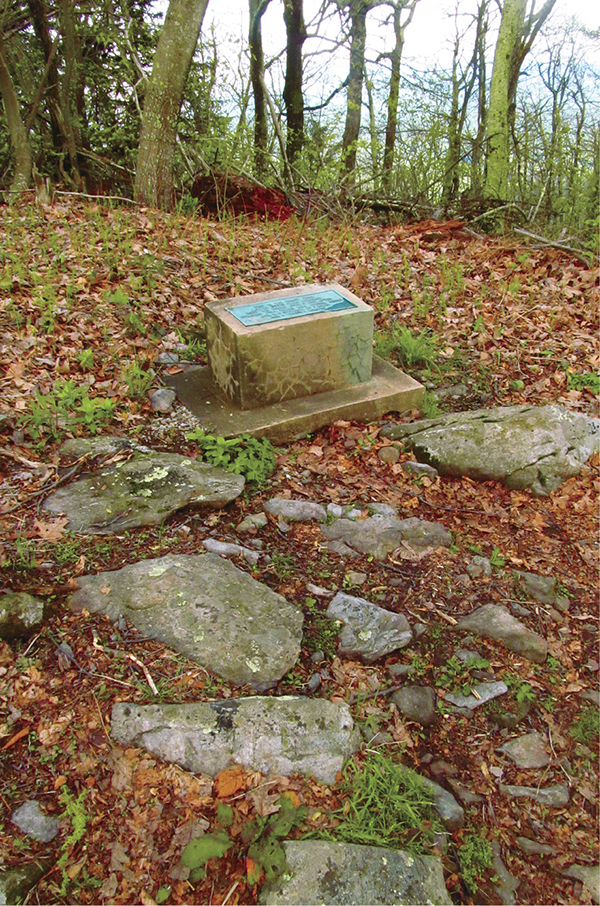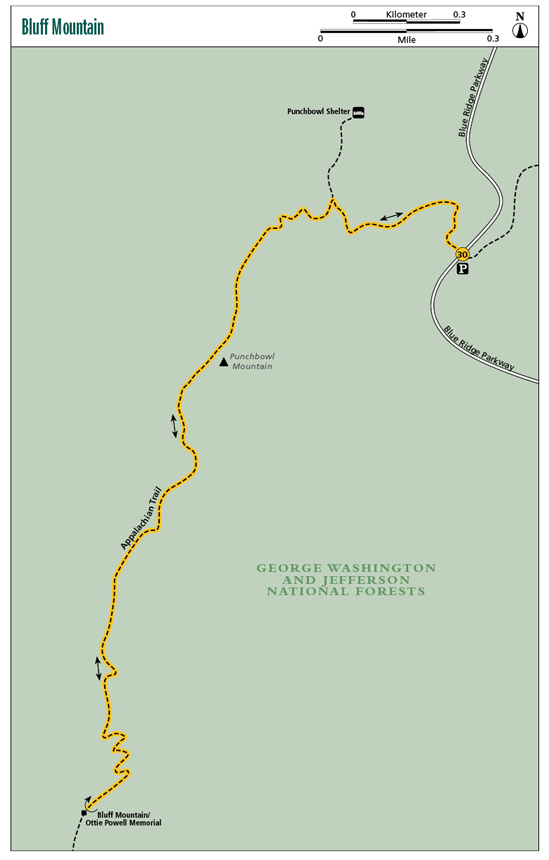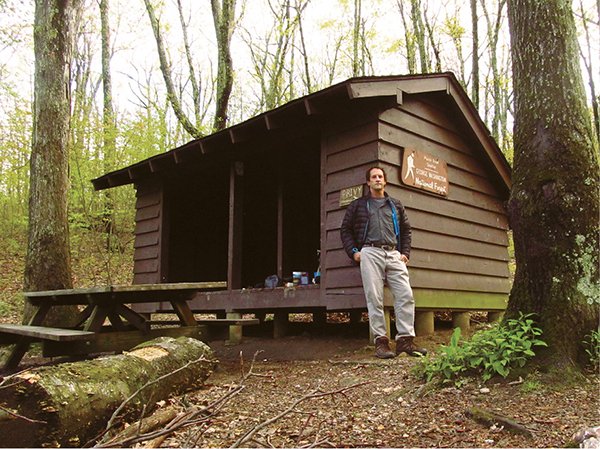
The memorial to Ottie Powell sits atop Bluff Mountain.
30 Bluff Mountain
This hike uses the famed Appalachian Trail (AT) to escort you up to Bluff Mountain, a somber yet scintillating place. Here lies a memorial to Ottie Powell, an area lad lost in the woods. His body was found here, astride the very peak of Bluff Mountain. The story of his disappearance and subsequent discovery has become legend. Hikers who overnight at the nearby Punchbowl Mountain trail shelter swear the ghost of young Ottie has come to visit them. Today, you can leave the Blue Ridge Parkway, hike the AT, pass the Punchbowl shelter, and walk on up to Bluff Mountain to see the wonderful panoramas and the memorial to Ottie. After that, decide for yourself if the ghost of Ottie Powell haunts these heights.
Start: Blue Ridge Parkway near milepost 51.5
Distance: 3.8 miles out and back
Hiking time: About 2.5–3.5 hours
Difficulty: Moderate, does have 1,200-foot climb
Trail surface: Natural
Best season: Year-round when skies are clear
Other trail users: None
Canine compatibility: Leashed dogs permitted
Land status: National park, national forest
Fees and permits: None
Schedule: 24/7/365
Map: National Geographic Map #789, Lexington/Blue Ridge Mountains, George Washington and Jefferson National Forests
Trail contact: George Washington National Forest, 27 Ranger Ln., Natural Bridge Station, VA 24579; (540) 291-2188; www.fs.fed.us
Finding the trailhead: From exit 188 on I-81, take US 60 east to and through Buena Vista for a total of 8 miles to reach the Blue Ridge Parkway. Take the Blue Ridge Parkway southbound for 6.1 miles to the Punchbowl Mountain Overlook, milepost 51.5, on your left. The “overlook” is actually a parking area for the Appalachian Trail and offers no views. From there, take the AT southbound, joining it across the parkway from the overlook. Do not follow the AT northbound directly from the overlook. Trailhead GPS: N37 40.446' / W79 20.065'
The Hike
There are several reasons why a mountain becomes iconic. Sometimes it is for the views, sometimes it is for what has happened there, and sometimes for the trails that course atop it. Bluff Mountain has become a Virginia Blue Ridge icon for all of the above reasons. You should visit it.
First, soak in the story of Ottie Powell. The last day of his life was what really puts Bluff Mountain on the map. Back in 1891, November it was, Ottie Powell, a little shy of 5 years old, walked to school in Amherst County, east of the Blue Ridge. It was not the only walking he was to do that day. Shortly after arriving, Ottie, along with the other children in the one-room Dancing Creek School, were sent into the adjacent forest to hunt up wood for the iron stove sitting in the middle of the wooden building. The teacher, Nanny Gilbert, had burned through the wood supply the previous week, as a surprise snowstorm had swept upon the Blue Ridge and adjacent communities.
The children returned to the school, wood in hand, except for Ottie. The search for him commenced immediately. It was not long before the whole community was searching for Ottie in the fields and forests east of the Blue Ridge. The cloudy afternoon darkened into dusk, and still no Ottie.
Then the rain fell. The temperature dropped. The rain turned to ice. The foul weather raised worries and dimmed hopes, especially among his parents. Where was Ottie Cline Powell? His story was passed house to house, town to town, by word of mouth and through the newspapers. The search grid expanded. At its height more than 1,000 people looked for Ottie, but as November does, it became colder, the days shorter. Hopes dimmed with the weather. Some began to wonder if he was kidnapped. Even Ottie’s dad, a part-time preacher, felt almost hopeless, especially after bringing in a big-city detective from Richmond.
The winter of 1891 became the spring of 1892. Still no Ottie Powell. His disappearance was a true mystery. Then bear hunters were tracking the high country when a hunting dog stopped tracking and started howling near the crest of Bluff Mountain, over 2,400 feet above the adjacent lowlands.

The memorial to Ottie Powell sits atop Bluff Mountain.
The dog had not cornered a bear but had found the remains of little blue-eyed, sandy-haired Ottie Cline Powell. By the contents of his stomach doctors determined he had passed away that first night away from the school, the night the rain turned to ice. Ottie Powell died of hypothermia. Nevertheless, how did he get 7 miles from home and a half mile higher than the old schoolhouse? Why did he end up on top of Bluff Mountain? To get a lay of the land? That seems a stretch for a lost not-yet-5-year-old, especially when you consider impending darkness followed by rain and ice.
However, die he did, and his mother followed him to the grave, stricken with grief. Ottie was buried in a field near his home. The tale of Ottie Powell grew to legend when a local resident wrote a book about the lost boy and even built a cement cross atop Bluff Mountain, honoring Ottie at the spot where he perished. By then the USDA Forest Service had bought the land, and Benton MacKaye’s idea of an Appalachian Trail took hold. A steel fire tower—a fire lookout—rose atop Bluff Mountain. The AT ran under it.
Visitors to the mountain, whose name was changed to Tower Hill because of the fire tower, grew curious about the cross and the story of Ottie Powell. Later, the bronze memorial we see today was erected. The fire tower, in existence since 1917, was dismantled. There was no more reason to call it Tower Hill, so the peak reverted to Bluff Mountain. That leaves today’s hikers with four concrete tower supports and a set of concrete stairs going nowhere, except a few feet higher atop Bluff Mountain, seemingly to improve the cleared vistas on the small grassy crown.
Now, we can peer down to the west on the Maury River Valley, where it flows by Buena Vista, and west beyond that to Lexington and Mill Mountain and all the way to West Virginia. To the east the James River Valley, with all its tributaries aiming for the Piedmont, can be seen coursing through knobby hills. Somewhere down there is Lynchburg. But perhaps the best vista of all is to the north, where the gentle and sometimes steep mountains—seemingly endless—of the Blue Ridge roll on, eventually becoming part of Shenandoah National Park.
Ottie Powell, the day he died, never beheld such a view. The wooded mountain was not cleared for aesthetic purposes. Ottie enjoyed no cleared trails. Ottie had no relatively easy marked path to follow, as we do today. The mystery remains: How did he end up on Bluff Mountain?
Some say his spirit can be felt on the peak. Hikers often leave trinkets for Ottie at the memorial. Others swear they hear a little boy crying for help at the Punchbowl Mountain trail shelter, which you pass on the way. I made a point to camp at the shelter but neither heard nor felt the vibes of Ottie during a long, dark night. Maybe I was not listening, but they say you can hear Ottie’s voice pealing through the wind-whipped trees, after the leaves have fallen, during the dark days of November—and beyond.
 Ottie Cline Powell was the fifth of eight children.
Ottie Cline Powell was the fifth of eight children.

Miles and Directions
0.0Start by heading southbound on the Appalachian Trail, across the parkway from the parking area. Climb up a little hollow. The ascent steepens underneath oak, maple, and hickory woods.
0.4Reach a trail intersection. A spur trail leads right a quarter mile to the Punchbowl Mountain trail shelter. Here you will find a three-sided wooden shelter, a pond and a small stone-encased spring, and a privy too. Perhaps you may hear the ghost of Ottie Powell. For now, stay left, still on the AT, ascending through mountain laurel and chestnut oaks growing amid scattered lichen-covered boulders.
0.6Level off on the crest of the Blue Ridge. Congratulations, you have just climbed 600 feet. Continue southbound on the AT. Begin working your way over gentle Punchbowl Mountain.
0.8The rocky path tops out on Punchbowl Mountain. An easy descent leads through hardwoods with scattered rhododendron and mountain laurel.
1.1Reach a gap between Punchbowl Mountain and Bluff Mountain. Ascend.
1.5Make the first of several switchbacks working up the north side of Bluff Mountain. Stunted pines bronze the trail bed with their needles. More switchbacks rise ahead.
1.8Come to the shoulder of Bluff Mountain. Winter views open to the east. Even if the view isn’t clear, fake it. It is a good way to catch your breath after those switchbacks.
1.9Open onto Bluff Mountain. Here, a grassy crown is marked with concrete foundations of the fire tower that stood for over five decades and steps leading nowhere. Cleared views open to the west and east of the Blue Ridge. Note the rectangular Ottie Cline Powell memorial. Backtrack.
3.8Arrive back at the Blue Ridge Parkway.

The author—not afraid of ghosts—stands right in front of the haunted Punchbowl Mountain shelter.